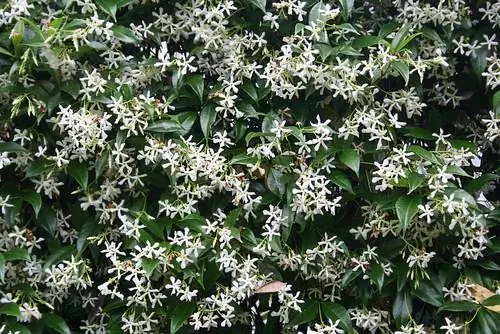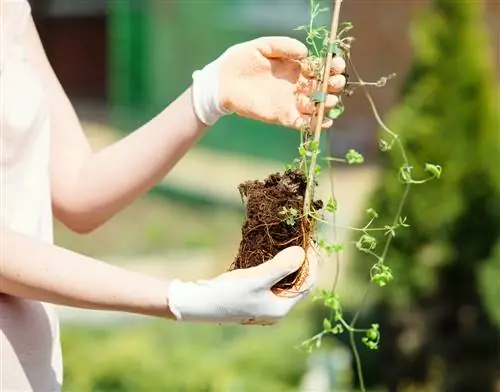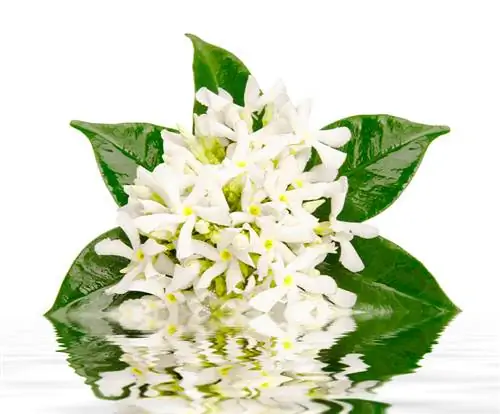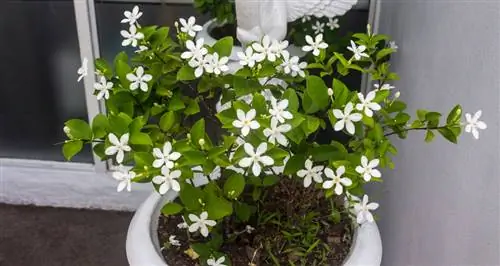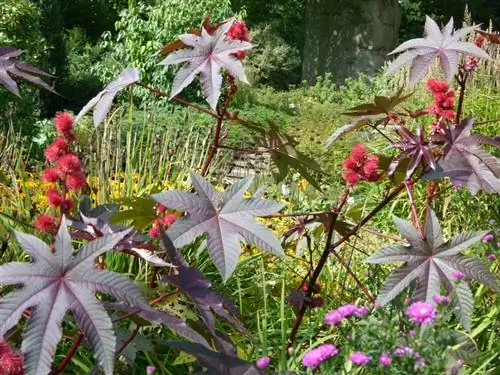- Author admin [email protected].
- Public 2023-12-25 17:45.
- Last modified 2025-01-23 11:21.
The graceful star jasmine (bot. Trachelospermum jasminoidis) is particularly enchanting with its numerous, star-shaped and white flowers, which stand out clearly from the strong green leaves. The delicate flowers of the fast-growing climbing plant are reminiscent of those of real jasmine with their vanilla scent. Read the following article to find out what you need to pay attention to when planting and caring for the robust plant.

How do I properly care for a star jasmine?
The star jasmine (Trachelospermum jasminoides) is a fast-growing climbing plant with star-shaped, white flowers and strong green leaves. It prefers a slightly sunny to partially shaded location and requires nutrient-rich potting soil. Regular watering, fertilizing and, if necessary, cutting promote growth and flower formation.
Origin and growth
The star jasmine (bot. Trachelospermum jasminoides), which we like to use as an ornamental plant, belongs to the genus star jasmine (bot. Trachelospermum), which is widespread in Asia and, botanically speaking, belongs to the dogpoison family (Apocynaceae). Of the approximately 20 species, in addition to Trachelospermum jasminoides, the species Trachelospermum asiaticum is also used worldwide as an ornamental plant. Trachelospermum jasminoides is at home in the forests of Japan and Vietnam, where the plant climbs trees and forms long, woody lianas.
Leaves, flowers and flowering time
The bright white, five-star flowers that appear in large numbers between April and August are characteristic. The oval, shiny green leaves turn reddish in autumn and form a striking contrast to the sea of flowers. Especially in warm, humid weather, the flowering plant also exudes a strong, vanilla-like scent that is reminiscent of real jasmine.
Toxicity
As a typical dog poison plant, star jasmine is unfortunately poisonous. Families with small children and curious pets in particular should avoid planting them, as the strong scent tempts them to try them - but all parts of the plant contain toxins that can cause unpleasant or even dangerous symptoms of poisoning. In the event of poisoning, you should definitely consult a doctor or veterinarian. The woody shoots, which are several meters long, also contain a poisonous milky sap, which can cause swelling, redness and even eczema when it comes into contact with the skin.
Which location is suitable?
The star jasmine is not sufficiently hardy in this country and should therefore not be planted in the garden. However, the species is ideal for growing in containers, for example on the terrace, balcony, in the winter garden or in the apartment - the last two options are even preferable, as the plant can stay in the same location all year round. Otherwise, the climbing plant feels particularly comfortable in a location with these characteristics:
- slightly sunny to partially shaded
- no direct midday sun
- airy, but not drafty, protected from the wind
- ideal for west or east balcony
- perfect for house wall or pergola
When looking for a location, remember that the star jasmine can quickly grow to several meters long and always looks for its way upwards - therefore a stable climbing aid is essential.
Floor
In order for the star jasmine to thrive and bloom prolifically in the pot, it needs high-quality and nutrient-rich pot plant soil. Be sure to buy a peat-free substrate and use a humus-based one instead. This contains all the nutrients important for flower formation. Alternatively, you can also use good garden soil, as long as you sterilize it in the oven or microwave before planting - otherwise there are likely to be unpleasant surprises with weeds or pests.
Mix the selected substrate with sand or gravel to increase permeability and thus reduce the risk of waterlogging. Clay balls or expanded clay are also suitable for this purpose. When using soil from the garden, you should also mix in mature compost or compost soil to increase the nutrient content.
Planting star jasmine correctly
Cultivate star jasmine in a bucket if possible, as the plant is not hardy in this country. If the plant cannot remain in its location all year round, you should plan the possibility of moving it to its winter quarters - this should be bright and cool, but definitely frost-free. The easiest way to move the plant pot is with a base frame with wheels, which you can place under the pot when planting. Overwintering at the location can take place as long as it has winter protection and does not fall below five degrees Celsius even when the outside temperature is very frosty.
Pot the star jasmine as follows:
- ideal planting time is spring
- Use a plant pot with a drainage hole at the bottom of the pot
- cover this with potsherds or stones
- these prevent sludging and thus clogging
- Pot should be twice as wide and deep as root ball
- Mix planting substrate with drainage material
- fill about a third into the plant pot
- Carefully hold star jasmine in
- Fill empty spaces with substrate
- Insert trellis
- Press the soil lightly
- pour heavily
Watering star jasmine
Star jasmine does not need a lot of water - quite the opposite, because the climbing plant only needs a little moisture even during the flowering period. Therefore, you should water the specimens that are in partial shade or shade very sparingly - excess water leads to disease and ultimately death. Waterlogging is particularly harmful. Excess irrigation water must be removed from the planter or pot at the latest half an hour after watering. Coasters to remove.
Fertilize star jasmine properly
Star jasmine only shows its long-lasting blooms when it is sufficiently supplied with the nutrients required for flower formation. Therefore, between April and November, you should fertilize about every two weeks with a high-quality pot or flowering plant fertilizer (€14.00 on Amazon), which you should preferably administer together with the irrigation water. A long-term fertilizer - for example in the form of sticks or cones that you stick into the substrate in spring - is also suitable for sufficient supply. During the winter months, however, stop fertilizing completely.
Cut star jasmine correctly
Pruning the attractive climbing plant is not absolutely necessary, but it is recommended before putting it into winter quarters. Regular thinning of shoots that have grown too densely makes sense so that the plant does not become bald from the inside - especially since the flowers cannot develop properly if the growth is too dense. Sufficient air and light is immensely important for the he althy growth of star jasmine. Therefore, use the scissors according to the following pattern:
- Pruning in autumn after flowering
- Thinning in spring and if necessary in summer
- thin out densely grown areas
- Remove individual, very long tendrils, especially from the inside
- remove old inflorescences
When cutting, be sure to use sharp scissors that have been disinfected with a suitable product so as not to squeeze the star jasmine unnecessarily and to reduce the risk of transmitting pathogens. You should also wear protective gloves to avoid contact with the toxic latex. Under no circumstances should this get into your eyes!
Repotting
You should repot the star jasmine once a year so that the plant can sprout better in fresh substrate and with more space and produce numerous new flowers. Therefore, the ideal time for such a measure is early spring. If the old planter still offers enough space for the roots, you do not have to replace it with a larger one - but replacing the used substrate still makes sense. When repotting, make sure to completely remove the old soil.
Propagate star jasmine
You can easily propagate star jasmine yourself both through seeds and vegetatively through cuttings.
Sowing
You can get germinable star jasmine seeds either from your own plant or from specialist retailers. Sow these in late summer (approx. from the beginning of September) in nutrient-poor seed soil and only press them in lightly. Cover the seed container with a translucent lid or foil to keep the humidity high (the gardener calls it “tense air”). This measure increases the germination rate and allows the young plants to grow faster. The plant pot also belongs in a place that is around 20 to 22 degrees Celsius warm and bright - but not directly sunny. Keep the substrate only slightly moist and use lukewarm water if possible. In the spring, finally transfer the young plants to a larger pot with nutrient-rich substrate.
Cuttings
To propagate from cuttings, cut shoots about ten centimeters long from the main shoots in August - after flowering. Put them in a container with growing substrate, which you cover with foil or a cut-off PET bottle. Like seedlings, the cuttings are kept warm and slightly moist in a bright location over the winter and are finally transferred to a larger container with fresh, nutrient-rich substrate in the spring. However, only give a little water during the rooting period and allow the substrate to dry out a little in between.read more
Wintering
Basically, star jasmine is not hardy and should therefore be moved to a cool and bright winter quarters of around eight to ten degrees Celsius in autumn. Even in winter, avoid the root ball drying out completely, which is why you should keep the substrate slightly moist. However, only water so little that the soil is slightly moistened. After the Ice Saints in May, the climbing plant can go outdoors again. Since the plant can tolerate short periods of low frost down to around minus five degrees Celsius, you can also plant it in regions with mild winters - for example in wine-growing regions. Then, however, the star jasmine needs light winter protection.
Diseases and pests
Unfortunately, star jasmine is quite susceptible to typical pests such as aphids, spider mites or mealybugs and mealybugs. Care errors - especially too frequent watering, but also excessive dryness - also lead to problems.
Tip
If you don't have a balcony or terrace, you can also cultivate the magical star jasmine in your apartment if you have enough space. Place the pot with the plant in a bright and airy place, but it should not be directly next to a heater - the climbing plant does not like dry heating air in winter. You should also avoid direct sunlight. However, avoid indoor culture if you have small children or pets (e.g. cats!).
Species and varieties
The white-flowering species Trachelospermum jasminoides looks very similar to the related, but yellow-flowering Asian star jasmine (bot. Trachelospermum asiaticum). The species also has very similar needs in terms of care and location.

